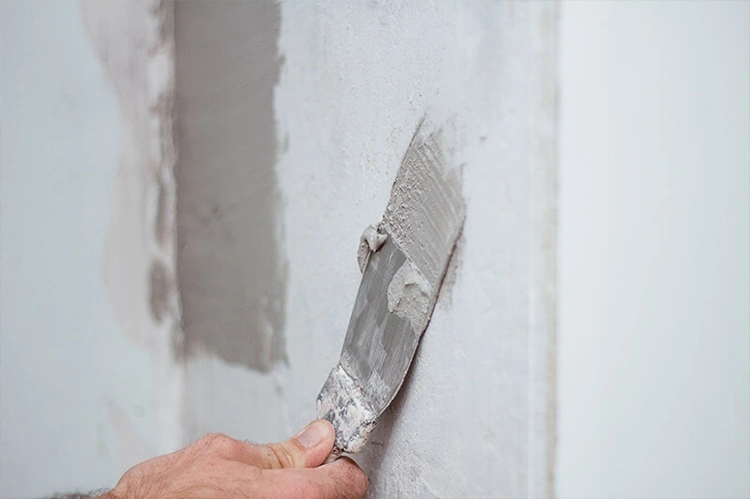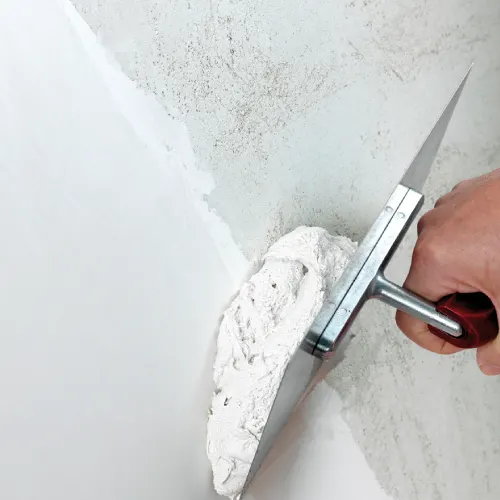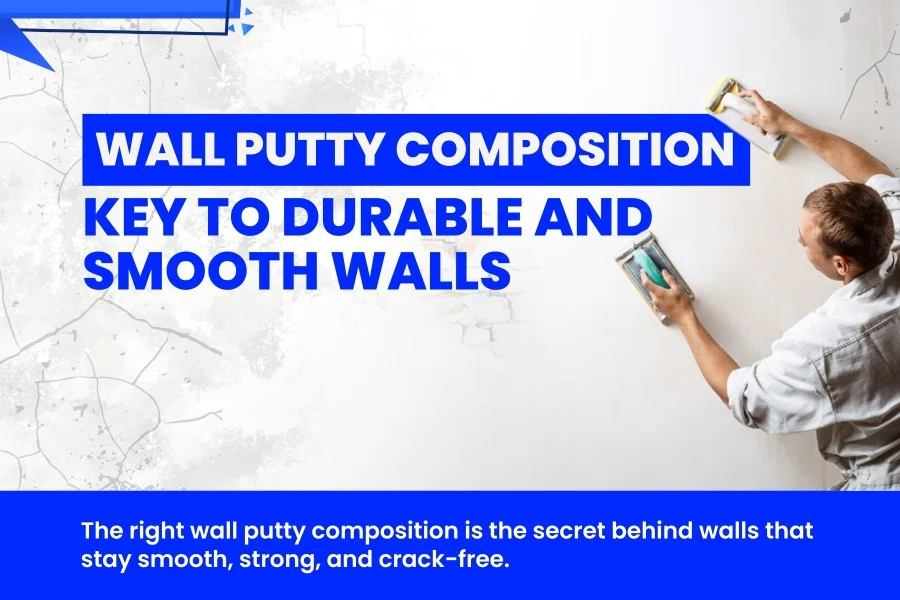Introduction
In today’s building and interior finishing world, aesthetics and durability are the most sought-after results. Although paint may be the “star of the show” in the end product presentation, the true “rock stars” are what’s hidden underneath-it-a a product/solution people spend little time thinking about- it’s called wall putty.
Wall putty may look like a straightforward product, but it serves several purposes. Wall putty is not just a filling agent- it is an adhesion improver, a paint protector, and a surface optimizer.
In this detailed article, we will discuss wall putty in detail by covering what wall putty is, its composition, how those things function, its application, its manufacturing, its benefits, and finally, what is important to understand about its composition for contractors and homeowners.
Table of Contents
What is Wall Putty?
Wall putty is a powder material made principally of white cement, fillers, and chemical additives, that when mixed with water, becomes a smooth paste.
This smooth paste can then be used to coat, wall surfaces before painting, to provide flatness, hide cracks, fill small holes, and prepare the wall for painting, thereby producing an improved overall finish.
Wall putty is more than a cosmetic consideration; it serves to prolong paint life by providing a chemically stable, moisture-resistant, and level surface, and it also protects against humidity, salinity, and temperature extremes—you need it if you live in a drastically fluctuating climate!
Types of Wall Putty
Wall putty comes in two main forms:
White Cement Putty
This is the most common form of putty on the market. White cement putty is primarily made from white cement and special additives. White cement putty can be used on both interior and exterior walls and provides excellent adhesion, durability, and water-resistant properties.
Acrylic Putty
Acrylic putty is a water-soluble compound that is more flexible than, and solely designed for use on interior surfaces, unlike cement based putties.
Acrylic putties have some advantages over white cement putties. They make a slightly smoother finish and can be easier to apply. They have lesser durability than white cement putty when exposed to outdoor conditions.
Let’s Examine the Components That Make Up Wall Putty
The performance and longevity of wall putty are reliant on its formulation. Let’s take a closer look at the components and their function:
1. White Cement (Binder) – 30 -60%
The primary binder in the majority of wall putties is white cement. The purpose it serves is to provide the putty with strength, hardness, and binding ability. White cement is a hydraulic binder in that when it reacts with water, it will form a hard and cohesive mass.
Function: Assist with wall adhesion and create a solid substrate for painting.
Why use white cement? It will not affect the color of the paints, especially the lighter tints, and it will give a neutral background for your work.
2. Fillers – 20%-50% – common fillers include:
- Calcium carbonate (CaCO₃)
- Dolomite powder
- China clay
- Talc
These products act as the “volume builders” of the putty. They help with texture smoothness, help cover surface issues, and improve coverage of the material.
Function: Bulk, reduce shrinkage, improve sandability
Note: The smaller the particle size and the less contamination of fillers directly they relate to the smoothness and finish of the wall.
3. Polymers – 2%-5% – water solvable polymers such as:
- Hydroxypropyl Methylcellulose (HPMC)
- Hydroxyethyl Cellulose (HEC)
- Redispersible Polymer Powder (RDP)
- Polymers help to improve the workability of the putty.
Function:
- To improve adhesion and flexibility.
- To retard cracking.
- To extend the open time for the application.
- To improve water and temperature variations.
- Polymers will make the putty more elastic and are going to reduce flaking or peeling once painted.
4. Additives – 1-5%
These are in minute quantities, but they are important when it comes to modifying performance characteristics. Some common additives are:
Preservatives: stop bacteria or fungus growth.
Dispersants: maintain adequate dispersion of particles.
Thickeners: Control viscosity; prevent sagging.
Water-repellent agents: Enhance the moisture resistance.
Plasticizers: Improve spreadability.
The selection of each of these components is specific to the climatic conditions to which the product will be exposed, the application method, and the requirements of the end-user.
The Wall Putty Production Process

Most wall putty is produced using a series of specifications and procedures to ensure quality, safety, and efficiency. The production of wall putty can be summarized simply as follows:
1. Selecting raw materials
The process begins with identifying raw materials, cement, fillers, and chemical additives. No matter how small, quality matters. Any change in quality can affect the usability of the final product.
2. Pre-mixing
All dry materials are weighted and pre-mixed in a dry blending system. This was important to create a uniform process before fine grinding.
3. Grinding and Homogenization
High-speed blending, and/or ball milling, and metal grade tubing are used to grind the mixture to the desired uniformity to obtain fine powder (with particle size distributions between 40 to 100 microns), and to produce a product with smooth texture and usability.
4. Quality Control
Every batch of the product must go through a rigid quality test that focuses on:
- Adhesion strength
- Setting time
- Consistency
- Moisture resistance
- Shelf life
5. Packaging
The finished product is packaged in multi-layer bags (most commonly consisting of a 20 kg or 40 kg bag) to ensure that moisture does not leak into the product, and to assist with storage if kept for long periods of time.
Application Techniques
Applying wall putty properly is essential for getting a perfect finish, and the application process if as important as the product. Here is a complete set of instructions to get the best results.
Preparation
First, you must clean the surface you want to treat. The surface should be free of dust, grease, and old paint to get a good bond. If the surface is very dry, you should moisten it before applying the putty.
Mixing
In a clean mixing container, mix the wall putty with water in a precise (2:1) ratio of putty to water. Mix with a mixing tool in the mixing container and vigorously stir to a smooth, lump-free paste. The paste should be creamy and consistent so it goes on smoothly.
Application
Using a good quality putty knife or trowel, spread the Wall Putty in bold strokes with even pressure. Apply the first coat smoothly, while filling in any imperfections. It helps to apply a thin coat, as air and decomposition gases need to escape. Allow this coat to dry at least 6 to 8 hrs before applying a second coat or other coatings.
If you need a second coat for the desired smoothness, do it the same way. In order to get the best finish for your next paint, you will need to let the final coat dry for a minimum of 24 hours.
Sanding
Once the final coat has dried completely, lightly sand the surface using fine emery paper. This process is important for you to get a silky feel, to get rid of any small imperfections, and to prepare the surface for painting. The end result will be a beautifully smooth surface to be coloured.
Benefits of wall-putty
Wall putty has a number of technical and economic benefits that improve quality and durability of wall finishes:
1. Shares the load
Wall putty provides a flat surface for the paint to go on. It provides the best possible conditions for your paint job, preventing peel, crack, blister, and so on. Allows the paint job to be bright and last for much longer.
2. Water management
Wall putty is formulated with water-repellent materials, provides certain resistance to moisture and efflorescence, and better maintains the appearance of the wall.
3. Cost-effectiveness
Though using putty on your walls may feel like an extra finishing process, it is a good investment. It decreases the amount of paint needed and prevents multiple coats, allowing for greater savings overall.
4. Aesthetic Quality
Wall putty also improves the end finish of your walls with a premium, smooth, professional finish. This smooth finish ensures that the aesthetic quality of your interior or exterior will look its best while establishing an inviting atmosphere.
5. Flexibility
Putty can be used on both interior and exterior projects, and it accommodates nearly all types of paints, offering flexibility for a variety of projects with consistent results.
Wall Putty vs POP (Plaster of Paris)
| Parameter | Wall Putty | Plaster of Paris (POP) |
| Base Material | White Cement | Gypsum |
| Strength | High | Brittle |
| Moisture Resistance | Excellent | Poor |
| Application | Interior & Exterior | Interior only |
| Durability | Long-lasting | Cracks easily |
| Cost | Slightly Higher | Cheaper |
Wall putty is your best option in terms of durability, moisture resistance, and a paintable surface that is long-lasting.
Change in the Environment and Health.
Modern wall putties are seeing a significant change as many wall putties are looking to become environmentally friendly and commit to user safety. The benefits of wall putties most recently highlight the following:
Low VOC (Volatile Organic Compounds) emissions: Induces favorable indoor air quality, and significantly less harmful to the environment and human health.
Overall, beneficial more than just the environment and according to the article developers have been using for all the aforementioned reasons or attempting to use greater, breatherable, less toxic products, simply improving safety and wellness environments and formalising large warnings put in places like hospitals schools and home.
Including antifungal and antimicrobial agents: This form of putty protects your surface from mold or bacteria and will be particularly valuable when used in sterile and clean areas.
Eco-friendly packaging: As a big push for sustainability, manufacturers are using recyclable or renewable packaging materials, etc and attempting to shrink a consumer’s carbon footprint and being aware and reduce many aspects of adverse ecology issues.
No lead or mercury: These formulations induce safer environments as consumers are not exposed to toxic or hazardous products.
These types of products and issues addressed are important, particularly when you enforce alternatives independently, where there is the issue of safety/wellbeing of people when attempting to impose the risk in hospitals, schools, homes, or community gathering areas, etc.
Common Problems and How to Avoid Them
Although wall putty is an important product in obtaining flat finishes, if there is any mismatch, it can become a disaster. To help illustrate any challenges you might come across here are some challenges you might encounter and their fixes:
1. Cracking After Drying
Causes: To make it seem impossible, this can usually be attributed to poor preparation of the surface or the putty being thinned too much, etc..
Fixes: To make sure you achieve this avoid this common concern, you will need to make sure the surfaces are clean prior to application, and free from dust, grease or anything else. You also need to adhere to the manufacturer’s recommended mixing ratio of water to putty to make sure you achieve the required thin consistency.
2. Peeling or Flaking
Causes: Moisture, or putting paint onto the putty too soon, can cause what is referred to as peeling or flaking because the putty may not of fully dried.
Fixes: To prevent the lingering effects of peeling or flaking, make sure the surface is dry before you apply anything. As a general rule, allow a minimum of 24 hours for the putty to properly cure and secure bonding before you apply a paint or primer.
3. Bubbling
Cause: Bubbling is caused by air pockets trapped during the application process, resulting in an uneven surface.
Solution: You can avoid bubbling by applying the putty in thin even layers without any irregularities. Using thin layers allows for even drying and minimizes air being trapped.
By following these instructions, you can improve the durability and aesthetic appeal of the wall finishes you create, so that you can achieve a professional-level finish.

Conclusion
Wall putty is more complex than just a technical composition, it is a science behind beautiful, long-lasting walls.
From the white cement base to the finer fillers, performance polymers, and other specialty additives, every ingredient has a unique role to play to provide strength, smoothness, and durability.
Selecting the right wall putty and putting it on correctly will save you time, money, and repairs down the road. Wall putty is an essential step that, when constructing a new home or for an old renovation, or for a repaint in a room, should not be overlooked or compromised.
Understanding wall putty from the inside out, through its chemistry, application, and benefits, is the key to creating walls that will both look spectacular and hold up.
Sagar Telrandhe is a Construction Engineer with a B.Tech in Construction Engineering & Management. Passionate about infrastructure development, project planning, and sustainable construction, he specializes in modern construction techniques, project execution, and quality management, contributing to efficient and innovative building.


